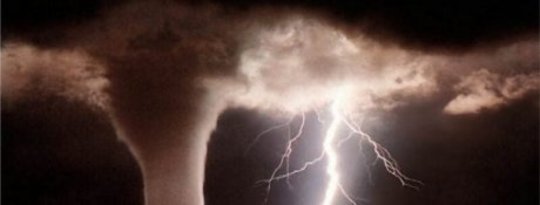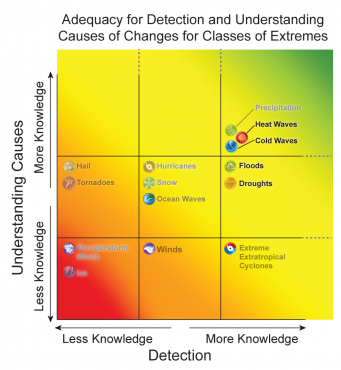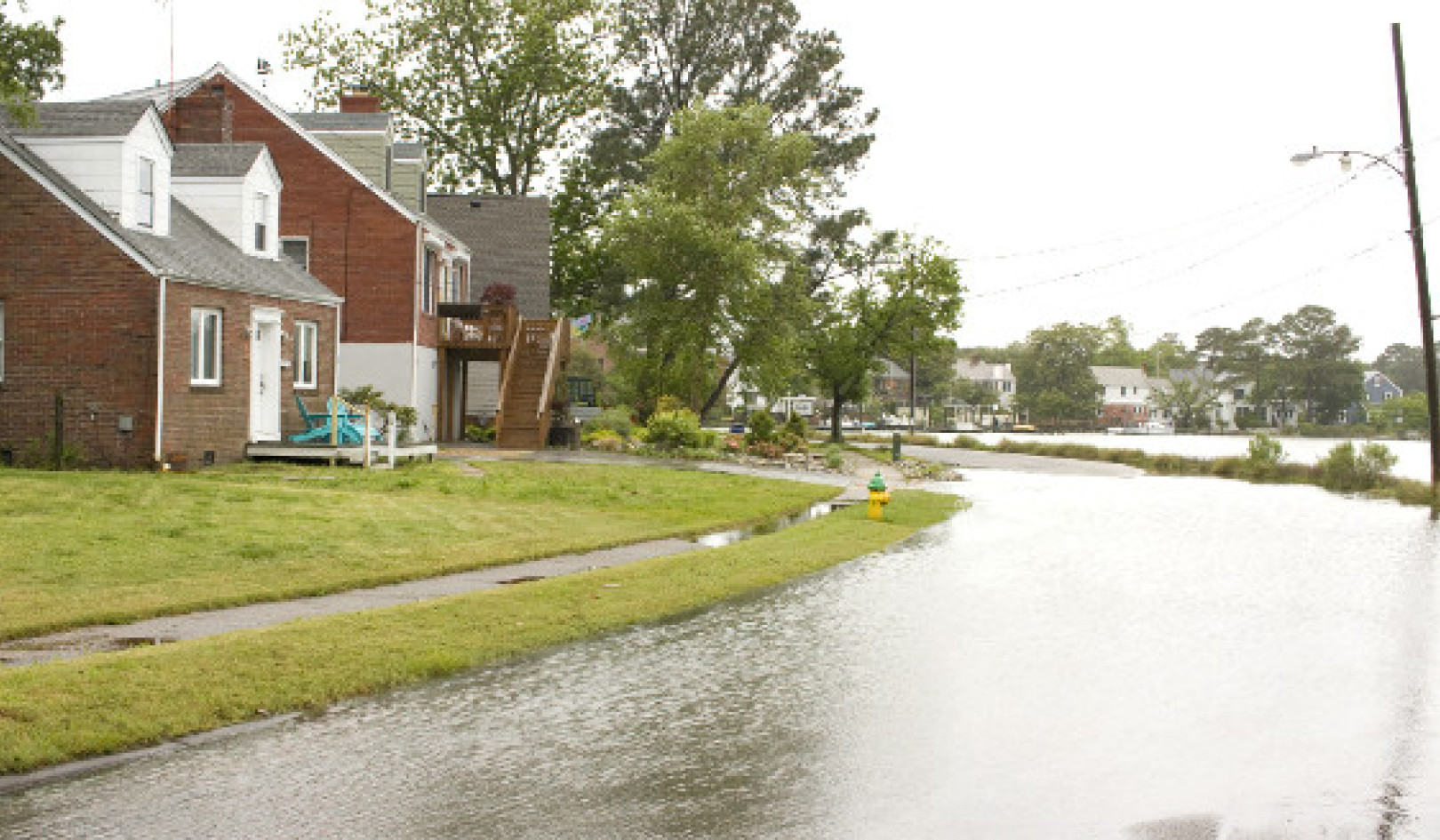
Changes in Heat Waves, Cold Waves, Floods, and Droughts in the United States
Regardless of where you live in the United States or even how old you are, you likely have witnessed at least one instance of severe weather phenomena that scientists call “extreme events.” Wind storms, tornadoes, hurricanes, and severe snowstorms, to name just a few, fall into that category. Scientists are actively studying the occurrence of extreme events to determine what causes them as well as to understand changes in the frequency of their occurrence. Such analyses are intended to better inform the public of the near- and long-term probabilities of encountering these events and their devastating effects.
The latest information from a series of workshops to study extremes This image shows the collective state of knowledge, garnered from workshops held at NCDC, in terms of the current understanding related to detection and attribution of the named extreme events. NCDC’s latest workshop resolved the appropriate location in this grid for heat waves, cold waves, floods, and droughts (shown in black text). The x-axis refers to the adequacy of data to detect trends while the y-axis refers to scientific understanding of what causes those trends. The dashed lines on the right side and top of the graph imply that the knowledge about the phenomena is not complete. is in the paper, “Monitoring and Understanding Changes in Heat Waves, Cold Waves, Floods and Droughts in the United States: State of Knowledge,” accepted by the Bulletin of the American Meteorological Society and available early online here. This paper is the result of the second workshop held at NCDC for the purpose of “rating the state of the understanding of the physical factors that cause these extremes to change and the adequacy of the data to accurately reveal long-term variability and change in these extremes, in comparison to each other and in comparison to the extremes assessed in the other workshops.”
This image shows the collective state of knowledge, garnered from workshops held at NCDC, in terms of the current understanding related to detection and attribution of the named extreme events. NCDC’s latest workshop resolved the appropriate location in this grid for heat waves, cold waves, floods, and droughts (shown in black text). The x-axis refers to the adequacy of data to detect trends while the y-axis refers to scientific understanding of what causes those trends. The dashed lines on the right side and top of the graph imply that the knowledge about the phenomena is not complete. is in the paper, “Monitoring and Understanding Changes in Heat Waves, Cold Waves, Floods and Droughts in the United States: State of Knowledge,” accepted by the Bulletin of the American Meteorological Society and available early online here. This paper is the result of the second workshop held at NCDC for the purpose of “rating the state of the understanding of the physical factors that cause these extremes to change and the adequacy of the data to accurately reveal long-term variability and change in these extremes, in comparison to each other and in comparison to the extremes assessed in the other workshops.”
In their study of those four extremes, the authors found that heat waves are occurring more often, while cold waves have been decreasing. That shift is recognized to be in keeping with a warming climate, but decadal variations in the number of heat and cold waves in the United States do not correlate well with the observed warming during the 20th century. Still, the scientists have fairly good understanding of the factors that cause the development of both events, and studying extremes continues to bring gains in the ability to detect such events, and thus forewarn the public, as well as to compare the frequency and extent of their occurrence with the past.
Scientists know, for example, that atmospheric moisture plays an important role in heat waves. They tend to occur more frequently in dry conditions with low humidity, but heat waves in high humidity can take their toll on the population, livestock, and wildlife. Similarly, in the study of river flooding, changes can be caused by variations in atmospheric conditions, land use/land cover, and water management, yet when those changes occur in tandem, determining the relative importance of each factor as drivers of observed changes makes analysis difficult. Therefore, scientists only assess basins that have had minimal water management and land-use changes. In studying annual peak flow data, the experts find that river flooding trends on the century-scale do not show uniform changes across the country: Flood magnitudes in the Southwest have been decreasing; flood magnitudes in the Northeast and North Central have been increasing.
With respect to drought, instrumental data indicate that the Dust Bowl of the 1930s and the drought in the 1950s were the most significant 20th century droughts in the United States, while tree ring data indicate that the megadroughts over the 12th century exceeded anything in the 20th century in both extent and duration. In fact, each extreme event has its own associated condition(s) that affect development. Nevertheless, as shown in the accompanying graphic, the authors indicate that they better understand the causes of changes in heat waves and cold waves than the causes of changes in floods and droughts, and the adequacy of the data for detecting and understanding the causes of changes in those four extremes is better than for some other extremes, such as hail, tornadoes, and hurricanes.
Originally published by National Climate Data Center

Related Books:
The Future We Choose: Surviving the Climate Crisis
by Christiana Figueres and Tom Rivett-Carnac
The authors, who played key roles in the Paris Agreement on climate change, offer insights and strategies for addressing the climate crisis, including individual and collective action.
Click for more info or to order
The Uninhabitable Earth: Life After Warming
by David Wallace-Wells
This book explores the potential consequences of unchecked climate change, including mass extinction, food and water scarcity, and political instability.
Click for more info or to order
The Ministry for the Future: A Novel
by Kim Stanley Robinson
This novel imagines a near-future world grappling with the impacts of climate change and offers a vision for how society might transform to address the crisis.
Click for more info or to order
Under a White Sky: The Nature of the Future
by Elizabeth Kolbert
The author explores the human impact on the natural world, including climate change, and the potential for technological solutions to address environmental challenges.
Click for more info or to order
Drawdown: The Most Comprehensive Plan Ever Proposed to Reverse Global Warming
edited by Paul Hawken
This book presents a comprehensive plan for addressing climate change, including solutions from a range of sectors such as energy, agriculture, and transportation.






















